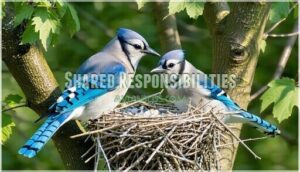This site is supported by our readers. We may earn a commission, at no cost to you, if you purchase through links.
 You’ve probably wondered if blue jays mate for life after spotting a pair working together in your backyard.
You’ve probably wondered if blue jays mate for life after spotting a pair working together in your backyard.
The answer isn’t quite that romantic. Blue jays don’t mate for life like some birds, but they’re not complete commitment-phobes either. They typically stay together for one breeding season, sometimes longer if things go well.
Think of it as serial monogamy rather than a lifelong marriage. These smart birds focus on raising their babies successfully, then may find new partners the following year.
Their loyalty depends on survival and breeding success rather than fairy-tale romance. Their fascinating courtship rituals reveal just how complex these partnerships actually become.
Table Of Contents
- Key Takeaways
- Blue Jay Mating Habits
- Do Blue Jays Mate Forever
- Blue Jay Courtship Behaviors
- Blue Jay Pair Bonding
- Blue Jay Lifelong Commitment
- Frequently Asked Questions (FAQs)
- How long do blue jays live?
- How do Blue Jays mate?
- Are Blue Jays monogamous?
- Are Blue Jays obnoxious?
- Are Blue Jays intelligent birds?
- What do Blue Jays do at the end of their life cycle?
- What happens when a Blue Jays mate dies?
- What does it mean when a blue jay hangs around your house?
- How do you tell if a blue jay is male or female?
- Can Blue Jays recognize you?
- Conclusion
Key Takeaways
- You won’t find blue jays mating for life like swans – they’re seasonal partners who typically stay together for one breeding season, with only about 20% maintaining longer bonds.
- You’ll witness incredible teamwork when blue jays pair up, as they share nest-building, feeding duties, and territory defense like a well-coordinated partnership.
- You can expect to see elaborate courtship rituals including aerial displays, food gifts, and vocal performances before blue jays commit to their seasonal partnerships.
- You’ll discover that when a blue jay loses its mate, it doesn’t stay single forever – these resilient birds actively seek new partners and can successfully remarry within the same breeding season.
Blue Jay Mating Habits
When you watch blue jays in your backyard, you’re actually seeing some of nature’s most devoted partners in action.
When blue jays lock eyes across the yard, you’re witnessing one of nature’s most romantic success stories unfold.
These bright blue birds form strong monogamous pairs and typically stay together for their entire lives, making them the relationship goals of the bird world.
Monogamous Partnerships
Blue jays practice social monogamy, forming strong pair bonds that showcase remarkable fidelity benefits.
You’ll find these monogamous birds demonstrate cooperative breeding patterns rarely seen in nature.
Their partnership strength creates a foundation for successful reproduction and survival.
Here’s what makes their bonds special:
- Shared nest-building responsibilities strengthen their connection
- Mutual feeding demonstrates trust and commitment
- Territory defense becomes a joint effort
- Divorce rarity reflects their dedication to partnership
This avian monogamy proves blue jays truly understand teamwork.
Their complex interactions include mobbing potential predators, which highlights their dedication to partnership and showcases a unique aspect of their behavior.
Lifelong Bonds
Building relationships that last isn’t just a human dream—blue jays master this art through incredible bond strength and mutual support.
These monogamous birds create partnerships based on shared experiences, from raising young to defending territory together.
Their devotion offers human inspiration for celebrating love, proving that avian monogamy demonstrates how bird family bonds can teach us about lasting commitment, and the importance of mutual support.
Courtship Rituals
When you watch blue jays during mating season, their courtship rituals reveal fascinating behaviors.
Males perform aerial displays while offering courtship feeding to potential mates.
You’ll hear vocal mimicry as they communicate through complex calls.
Mutual preening strengthens trust building between pairs.
These courtship rituals help determine whether blue jays mate for life, showcasing intricate bird behavior patterns that establish lasting bird mating bonds, including mutual preening.
Do Blue Jays Mate Forever
Science reveals that blue jays don’t technically mate for life like swans or geese, but their commitment comes pretty close. These intelligent birds show remarkable fidelity factors during breeding seasons, with most pairs staying together for multiple years.
Bond strength between blue jay partners often rivals what you’d see in human parallels – they’re devoted parents who share responsibilities and communicate constantly. Bird behavior studies show their "divorce rates" are surprisingly low compared to other species.
When blue jays do separate, it’s usually because one partner dies or fails to return from migration. The monogamy benefits are clear: experienced pairs raise more successful broods and defend territory better together. Blue jays also exhibit complex vocalizations for communication.
While not technically lifelong partners, their animal partnerships demonstrate incredible loyalty. These bird mating habits prove that blue jays value stable relationships, making them one of nature’s most committed couples in the avian world.
Blue Jay Courtship Behaviors
You’ll notice that blue jay courtship looks a lot like teenage dating drama, with groups of 3-10 birds chasing each other around while the female plays hard to get.
These flashy displays include everything from fancy aerial stunts to sweet food gifts, proving that even birds know the way to someone’s heart is through their stomach.
Male Displays
When courting, male blue jays put on quite the show with impressive aerial displays that’ll catch any female’s attention.
You’ll notice their plumage brightness becomes more pronounced during mating season.
These courtship rituals include aggressive displays toward rivals and elaborate vocalizations that sound like nature’s own love songs.
Male blue jay behavior transforms completely when seeking their perfect mate.
Gift Exchange
Gift exchanges between blue jays mirror romantic gestures you’d recognize. Males present food offerings to females during courtship rituals, creating symbolic meaning that strengthens their pair bond formation.
This reciprocal altruism shows surprising human parallels in mating behavior. Blue jays often enjoy high quality insect protein during courtship.
Key courtship rituals include:
- Males offering insects and seeds
- Females accepting gifts as trust signals
- Shared foraging strengthening bonds
- Food exchanges continuing through breeding, which is a part of their pair bond formation.
Vocal Signals
Blue jays don’t just give gifts—they sing love songs too.
You’ll hear males using complex vocalizations during courtship rituals, from soft warbles to elaborate calls.
Their song complexity varies by region, creating unique regional dialects.
These birds even use mimicry purposes, copying hawk calls to impress potential mates.
Their communication range extends far beyond simple alarm calls, showcasing sophisticated avian courtship through diverse bird communication methods, including elaborate calls.
Body Language
Through feather displays and posture meanings, you’ll notice Blue Jays communicate their romantic intentions clearly.
Males puff their crests and spread wings during courtship rituals, while females respond with subtle head movements and tail positions.
These wing signals aren’t just showing off—they’re essential for pair bond formation and establishing monogamy, creating the foundation for their remarkable fidelity.
Blue Jay Pair Bonding
You’ve probably watched couples work together like a well-oiled machine, and that’s exactly what blue jay pairs do once they’ve bonded.
These feathered partners don’t just stick together for romance—they create a true partnership where both birds share parenting duties, communicate constantly, and rely on each other for survival in ways that might surprise you.
Shared Responsibilities
Once you’ve witnessed their courtship rituals, you’ll notice how blue jays split household duties like seasoned partners.
Both tackle nest building together, weaving twigs and roots into their future nursery. They share food gathering responsibilities and coordinate territory defense against intruders.
Blue Jays require specific materials for nest building.
This teamwork strengthens their pair bond formation, proving that successful mating behavior requires genuine partnership beyond initial attraction.
Brood Care
Once you’ve watched blue jays share nest building duties, you’ll see their teamwork shine during brood care.
Both parents take turns feeding young with insects and soft foods. They’re like tag-team wrestlers – when one’s tired, the other steps in.
This cooperative breeding continues through fledgling care, with parental roles clearly defined for successful jay breeding and bird reproduction.
Blue jays also exhibit complex vocalizations for communication.
Communication Between Mates
Through constant chatter and shared activities, you’ll notice blue jays maintain incredibly strong communication with their lifelong partners.
These bird relationships showcase remarkable coordination that strengthens their monogamous bonds.
Five key communication methods in blue jay partnerships:
- Vocal Duets – Synchronized calls that reinforce their connection
- Shared Foraging – Coordinated hunting strengthens teamwork
- Mutual Preening – Gentle grooming builds trust
- Warning Signals – Alert calls protect their mate
- Territory Defense – Joint protection of their space
Blue Jay Lifelong Commitment
You’ve learned that blue jays form strong partnerships, but their commitment doesn’t always end when life throws them a curveball.
While these birds typically stay with their chosen mate for years, they’re also practical enough to find new love if their partner doesn’t return from migration or faces other challenges.
Impacts of Mate Loss
Blue jays experience profound emotional turmoil when their lifelong partnerships end.
You’ll observe dramatic changes in their daily routines as pair bond disruption triggers cascading effects throughout their lives.
Breeding success decline becomes inevitable, while social structure changes leave surviving birds struggling to maintain their place within the flock’s complex hierarchy.
| Impact Category | Observable Changes |
|---|---|
| Behavioral | Restlessness, increased movement patterns |
| Physical | Weight loss, reduced appetite |
| Social | Isolation from established networks |
| Reproductive | Abandoned nests, decreased success rates |
Foraging behavior shifts dramatically as grieving birds lose their hunting partnerships.
These birds are native to North America, thriving in diverse environments.
This increased vulnerability puts them at higher risk for predation, making recovery even more challenging for these naturally monogamous creatures.
Finding New Partners
When death or divorce causes separation, blue jays don’t stay single forever.
These resilient birds actively seek new partners through the same courtship rituals that formed their original bonds.
Partner selection remains essential – they evaluate genetic compatibility and territorial quality just like before.
Widowhood impact varies, but most successfully remarry within the breeding season, proving their remarkable adaptability in lifelong partnerships.
They typically form lifelong pair bonds.
Conservation Efforts
Scientists protect blue jay pairs through targeted bird conservation efforts.
When habitat destruction threatens their lifelong bonds, conservation organizations step up.
To help, consider supporting bird habitat products.
Modern bird conservation focuses on three key strategies:
- Habitat Preservation – protecting mature forests where pairs nest and raise families
- Predator Control – managing threats that separate bonded mates
- Pollution Impact reduction – addressing West Nile Virus and climate change effects on bird population stability
Threats to Mating Pairs
Predator-pressure intensifies challenges facing blue jay monogamy partnerships.
You’ll notice domestic cats and bird predators like hawks threaten these devoted pairs daily.
Habitat loss from deforestation forces jay lifespan reductions, while human interference disrupts nesting sites.
Climate change alters food availability, and disease risk from West Nile Virus creates additional survival pressures that can separate lifelong blue jay mates permanently.
Frequently Asked Questions (FAQs)
How long do blue jays live?
Coincidentally, while you’re wondering about their lifespan, blue jays face similar aging challenges as humans.
In the wild, you’ll find they typically live 7-10 years, though some lucky ones reach 17 years.
How do Blue Jays mate?
Blue jays court through aerial displays, vocalizations, and playful interactions.
Males offer food to females as courtship gifts, demonstrating their reliability.
Once paired, they’ll build nests together and share parenting duties throughout the breeding season.
Are Blue Jays monogamous?
Like lovebirds in a fairy tale, you’ll find Blue Jays are indeed monogamous during breeding season.
They form strong pair bonds, often staying together for life, sharing nest-building duties and raising their young as devoted partners, which showcases their devoted nature.
Are Blue Jays obnoxious?
You’ll find Blue Jays aren’t truly obnoxious—they’re just loud and assertive.
Their boisterous calls serve important purposes like warning other birds of danger and communicating with their flock members effectively.
Are Blue Jays intelligent birds?
You’ll be amazed by their problem-solving skills and tool use in captivity. They understand waiting, imitate hawk calls strategically, and demonstrate complex social behaviors that rival many mammals in intelligence.
What do Blue Jays do at the end of their life cycle?
As these brilliant birds reach their final years, they’ll naturally slow down and become more vulnerable to predators.
You’ll notice they spend quieter moments with their lifelong mates before peacefully passing away.
What happens when a Blue Jays mate dies?
A broken wing still searches for its partner.
When a Blue Jay’s mate dies, you’ll see the survivor spending days calling and searching before eventually accepting a new mate if one becomes available nearby.
What does it mean when a blue jay hangs around your house?
A blue jay hanging around your house likely means you’ve got something it wants – good food sources, water, or potential nesting spots.
It’s basically saying "this looks like prime real estate!
How do you tell if a blue jay is male or female?
Can you spot the difference between male and female blue jays?
You can’t distinguish them visually since they look identical.
However, males are slightly larger and often act more dominant during feeding times.
Can Blue Jays recognize you?
Yes, you’ll be amazed that blue jays can actually recognize individual humans.
They’re incredibly smart birds who remember faces, especially if you’ve been feeding them regularly or they’ve had memorable encounters with you.
Conclusion
Research shows that roughly 80% of blue jay pairs stay together for just one breeding season.
Now you know the truth: blue jays don’t mate for life like swans or geese.
Instead, they’re seasonal partners who focus on raising healthy chicks together.
If you spot the same pair in your yard next spring, consider yourself lucky to witness their rare continued bond.
These intelligent birds prioritize survival and successful breeding over romantic commitments, making their partnerships beautifully practical.












